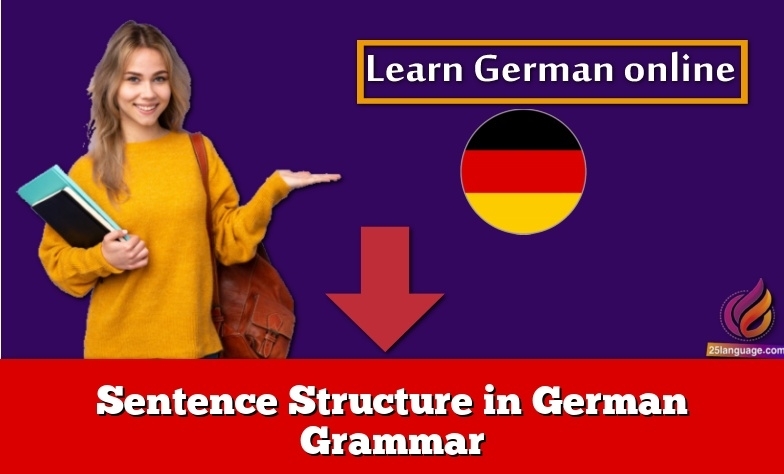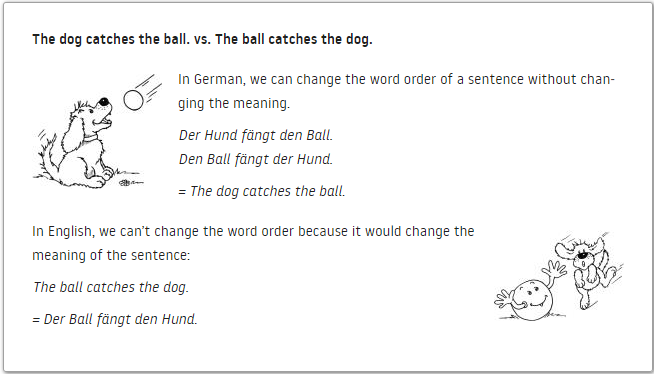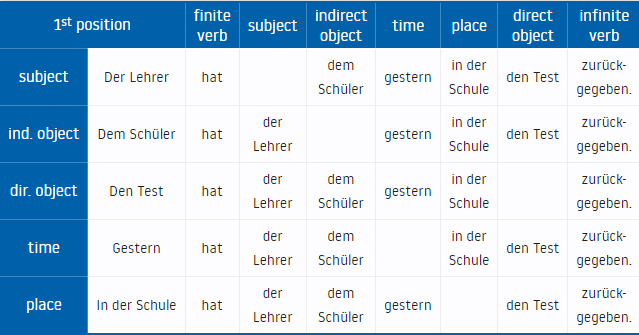Sentence Structure in German Grammar

as a Learner of German grammar you should learn about sentence structure in German. In addition to the words order in German sentences. So Our complete grammar explanations make learning German easy. Learn the most important rules and their exceptions and master verb conjugation in various tenses. our lesson is about sentence structure and word order in German Grammar.
With hundreds of interactive exercises for beginners through to advanced German learners, you can practise what you have learnt and master the German language.
Main Clauses – Declarative Sentences in German Grammar
Main clauses, also called independent clauses or declarative sentences in German (Hauptsätze/Aussagesätze in German), are clauses that can stand alone as a complete sentence. At a minimum, they include a subject, a verb, and an object and express a complete thought.
Word Order in German Sentences
Simple declarative sentences in German grammar can follow the same pattern as declarative sentences in English grammar: subject – verb – object. However, because the four cases allow us to see if a noun or pronoun is being used as a subject or an object, we can change the word order of sentences in German to emphasise different things.
Example

Basic Rules
The basic rules for word order are:
- The finite verb is always in the second position of a sentence.
- Infinite verb forms such as infinitives or past participles are placed at the end of the sentence.
- In many cases, the subject is at the beginning of the sentence. However, in German, other parts of the sentence such as the object, the place, or the time can be at the beginning of the sentence. In this is the case, the subject comes after the finite verb.
The following format is the correct order for sentence construction in most cases

But don’t forget:
When the direct object is a pronoun, it comes before the indirect object.
Example:den Test = ihn
- Der Lehrer hat ihn dem Schüler gestern in der Schule zurückgegeben
Besides the basic rules, there are many more possibilities for how to arrange the parts of a sentence in German.
Relationship Between Sentences
In texts and written German, it’s important to connect sentences to each other according to their content. Therefore, the part of the sentences that creates this relationship goes in the first position.
Example: Wir waren gestern im Museum. Dort war es sehr voll.
Old Before New
Something that is already known or is assumed to be known, is placed closer to the beginning of a sentence. Unknown or new information is put further towards the end of the sentence.
For this reason, when the direct object is a pronoun, it comes before the indirect object. After all, pronouns replace nouns that have already been mentioned or are assumed to be known.
Example: Der Lehrer hat ihn (den Test) ihm (dem Schüler) gestern in der Schule zurückgegeben
If the direct object is being used with an indefinite article, it must always come after the time and place. Remember that we use the indefinite article (ein…) to mentioning something for the first time i.e. something new.
Example: Der Lehrer hat dem Schüler gestern in der Schule einen Test zurückgegeben.
Emphasis at the End of the Sentence
The indirect object, time, and place are interchangeable. To really emphasise one of these parts of the sentence, put it after the direct object.
Example: In der Schule hat der Lehrer gestern den Test einem Schüler zurückgegeben.
Example: Der Lehrer hat dem Schüler den Test gestern in der Schule zurückgegeben

Improve your German Grammar with Learn German online. As you noticed that sentence structure in German different from the other Languages. Each grammar topic comes with one free exercise where you can review the basics, as well as many more exercises where you can practise according to your level. we wish you the best.





























